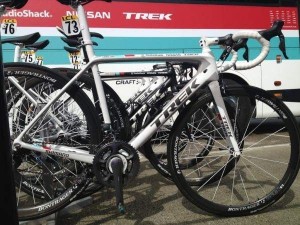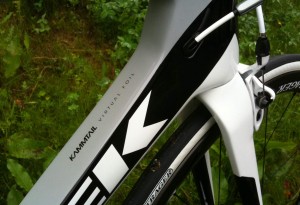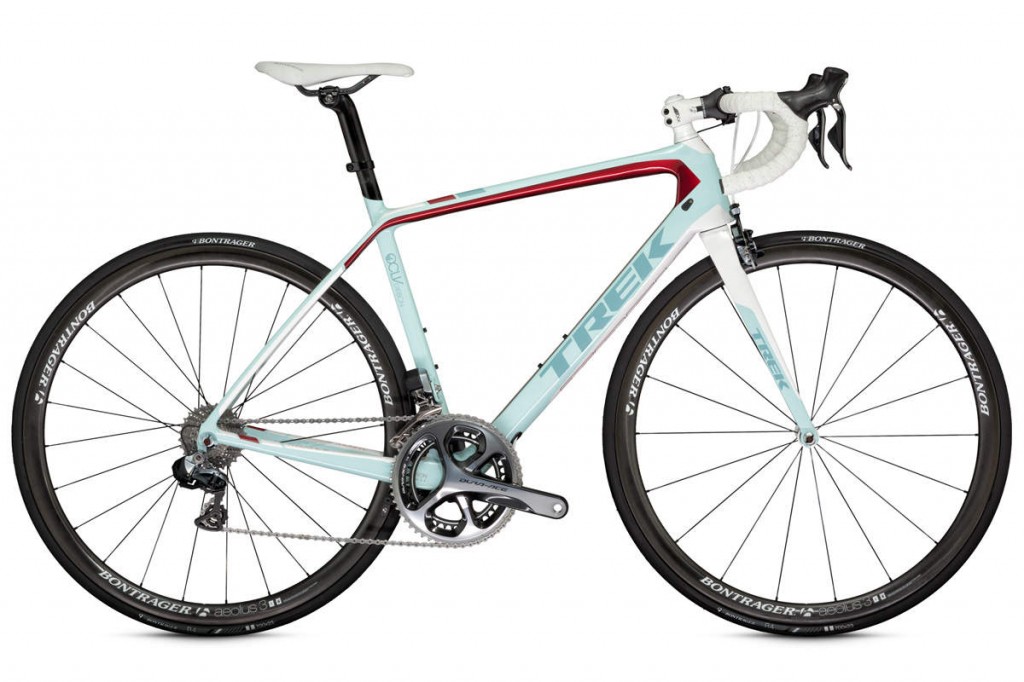Trek Madone 7 Aero Road Bike is getting in on the aero trend a few years late, but with the new Madone 7 series, the Wisconsin-based company is getting slick to the wind in a big way.
Why the long wait? Trek president John Burke said he didn’t want to come out with an aero road bike until the company could do it right. According to Trek, “doing it right” means a frame that weighs 750 grams and uses carefully shaped tubes to give a significant advantage against the wind.
The new Madone frame uses the Kammtail virtual foil shape—a design Trek first used on its Speed Concept triathlon and time trial bike, launched in 2010. The Kammtail tube shape causes the air passing around the bike to behave as it would blowing by a longer airfoil, even though the Kammtail tube itself is fairly short. The resulting tube shapes are stiff and lighter than a traditionally shaped aero tube.
Trek also saves weight—and gives itself another aero advantage—by using integrated brakes. The front brake has a dual-post mount, commonly seen on TT bikes, and tucks into the fork. The rear brake hides under the seatstays, allowing Trek to save even more weight by removing the brake bridge. The bike comes with Bontrager calipers, but you can upgrade to Shimano’s new Dura-Ace 9000 brakes.
The rear brake caliper is hidden below the chain stays and bottom bracket.
Trek says that these improvements, compared with a non-aero frame, save a rider 25 watts when moving at 25 mph with a head wind at 10 degrees. That means a typical hour-long ride would take 58 minutes on a Madone 7, assuming every other variable (wind conditions, rider, course) remained the same.
 I rode the bike in Belgium, just a few days before the Tour de France was set to roll out. We followed a 60-kilometer test loop that toured the hilly Ardennes region. The new Madone is a stiff, efficient race machine, even stiffer than the non-aero 2012 Madone—I couldn’t get this bike to flex at all, even when scaling a 20-percent grade on the famed Stockeu climb. Descents gave me the chance to take advantage of the bike’s crisp handling, which is just as sharp as you’d expect from a bike at this level. On rougher patches of pavement, and while passing over Belgian cobbles, the ride was very firm, but this may have had as much to do with Bontrager’s latest Aeolus carbon clincher wheels as the frame.
I rode the bike in Belgium, just a few days before the Tour de France was set to roll out. We followed a 60-kilometer test loop that toured the hilly Ardennes region. The new Madone is a stiff, efficient race machine, even stiffer than the non-aero 2012 Madone—I couldn’t get this bike to flex at all, even when scaling a 20-percent grade on the famed Stockeu climb. Descents gave me the chance to take advantage of the bike’s crisp handling, which is just as sharp as you’d expect from a bike at this level. On rougher patches of pavement, and while passing over Belgian cobbles, the ride was very firm, but this may have had as much to do with Bontrager’s latest Aeolus carbon clincher wheels as the frame.
The Madone 7.9 features Shimano Di2 and an $11,550 price tag.
Determined to make that frame as light as possible, Trek uses OCLV carbon for the dropouts, water bottle bosses, and front derailleur mount. There’s an integrated chain keeper, but it adds very few grams. Trek even offers a U5 Vapor paint option that it claims adds just five grams to the naked frame. (A standard paint job boosts frame weight by 40 to 80 grams.) With all of these savings, the Madone 7 frame is 165 grams lighter than the 2012 6.9 SSL, Trek’s previous top-end race bike.
The only elements held over from the 6.9 SSL are the BB90 bottom bracket, no-cut seatmast, and DuoTrap Ant+ computer sensor. The fork still relies on Trek’s Asymmetric E2 tapered steerer, but the fork blades share the frame’s Kammtail shape, and a new carbon lay up means that the whole thing is 10 grams lighter than the previous Madone fork. Trek says that’s it’s stiffer, too. The bike’s internal cable routing will work with both mechanical and electronic shift systems.
Compared to the 6.9 SSL, the geometry changes only slightly: The chainstays are shorter to tuck the wheel closer to the seat tube, and the top tube is 5mm longer, to facilitate an aerodynamic riding position. In addition to the aggressive H1 fit, you can get your Madone 7 with a taller head tube in Trek’s H2 geometry.
The Kammtail design tricks wind into acting like the tube shape extends further back
Of course, the top-end Madone 7—with all of those impressive aero and weight-savings—comes at a price. Team RadioShack-Nissan’s Madone 7s at the Tour de France run $12,600, while the frameset runs $4,200. However, models are available in lower grades of carbon and with lower-end components. The Shimano Ultegra-equipped Madone 6.2 uses the same aero shapes and as a complete bike, starts at $4,620. Like the 7 Series, it’s made in the U.S. 5 Series bikes start at $3,770, and also use the Kammtail tube shape. The 4 and 3 Series Madones use the current, 2012 frame shape. All of the carbon models are also available in WSD women’s specific versions as well, with a slightly more upright stance.
For riders not excited about carbon, or looking to save even more money, the aluminum 2 Series Madone represents an impressive value, and uses the same Kammtail airfoil shapes, but the bike costs just $1,430.
Although the Madone 7 was the focus of its launch, Trek also announced lower cost 5, 4, and 2 Series versions of the smooth riding Domane Classics bike. The company says that all of these bikes will be available at dealers in late July or early August.
Summary =
Why the long wait? The new Madone frame uses the Kammtail virtual foil shape—a design Trek first used on its Speed Concept triathlon and time trial bike, launched in 2010. The resulting tube shapes are stiff and lighter than a traditionally shaped aero tube.
Trek also saves weight—and gives itself another aero advantage—by using integrated brakes. The rear brake hides under the seatstays, allowing Trek to save even more weight by removing the brake bridge. The bike comes with Bontrager calipers, but you can upgrade to Shimano’s new Dura-Ace 9000 brakes.
The Madone 7.9 features Shimano Di2 and an $11,550 price tag.
(A standard paint job boosts frame weight by 40 to 80 grams.) With all of these savings, the Madone 7 frame is 165 grams lighter than the 2012 6.9 SSL, Trek’s previous top-end race bike.
The fork still relies on Trek’s Asymmetric E2 tapered steerer, but the fork blades share the frame’s Kammtail shape, and a new carbon lay up means that the whole thing is 10 grams lighter than the previous Madone fork. The Kammtail design tricks wind into acting like the tube shape extends further back.
The 4 and 3 Series Madones use the current, 2012 frame shape. Although the Madone 7 was the focus of its launch, Trek also announced lower cost 5, 4, and 2 Series versions of the smooth riding Domane Classics bike.
Source = bicycling


